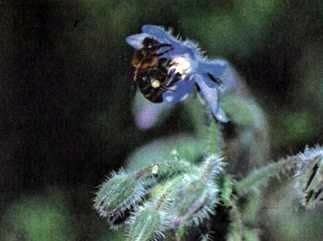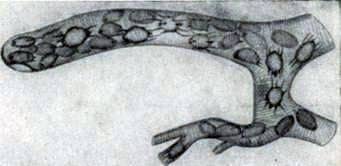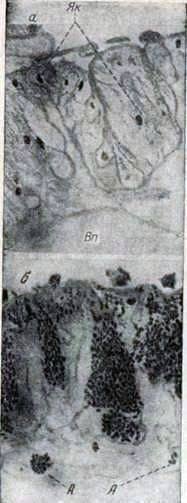
The well-being of a bee family can be endangered, because it easily excites the greed of various gourmets. The bee colonies would have disappeared long ago from the face of the Earth if they had not protected their sweet winter stocks with poisonous weapons. In the homeland of their ancestors, in the ancient forest, from time immemorial, the biggest gourmets were bears, ruining many bee colonies.
When the bears were less, the person himself thoroughly engaged in the plunder of honey. The present surplus of sugar extracted from beets, which is grown on domestic lands, is a relatively recent achievement. Previously, this sweet substance was obtained from sugar cane and brought to us from the Far East, and later – from America. Until now, some domestic housewives have preserved silver sugar bowls with locks, the key to which has long been lost. These ancient things show how expensive the contents of sugar bowls were in the days of our great-grandmothers. Then the demand for honey was completely different than it is now, and a few centuries ago Europeans did not know any other sugar than the one that the bees collected. No wonder man was the worst enemy of bees.
However, later the circumstances changed. Now bees have become for man the favorite pets, for which he cares and who take only the excess of honey. The romantic times of the bears also passed. And small creatures, such as ants, wasps, butterflies, hunted to honey, dead head or a mouse caught in a hive – although sometimes they pester the bees, but they can hardly cause them serious harm.
Yet it would be wrong to consider that no one is disturbed by peace and peace of the bee family. The bees still have so many enemies that only they could write a whole book.
Such books already exist. Let the beekeeper use their advice in order to learn to recognize the enemies of bees and fight them. Here we would like to talk a little about those of them, which are to some extent interesting in themselves.
Wax moth.
In addition to robber wasps and gourmet flies, the bees have another very common and especially harmful enemy. This is a wax moth butterfly, a relative of the well-known moth. They have much in common with each other. Both are real little butterflies. As it usually happens in butterflies, they hatch from eggs in the form of caterpillars, assiduously fattened and then turn into pupae, so that after a long period of rest, the pupae shells are discarded and moths born.
Being already quite developed butterflies, they both can not devour anything from our or from bee stocks, because their mouth parts are atrophied. They are not able to eat at all and all their short, life-measured lives are fed by fat stored in the caterpillar stage. In both cases, the caterpillars are pests, and in both cases they like material that is not at all digested by our stomach, as, indeed, the stomachs of almost all other living things.
Although woolen fibers and similar materials that are the victim of larvae of moth, as well as wax of honey combs, destroyed by wax moth larvae, are high-value nutrients, but they are difficult to break. The ability of caterpillars of moles to digest these sources of nutrients constitutes a special secret of their specialized digestive juices. The horny mass, from which the hair consists, is a protein substance containing everything that is necessary for building a body. Wax is a non-proteinaceous, fat-close compound, so a wax moth can not develop if it is fed with a single wax. She needs a protein containing feeding, which she finds in abundance in honeycombs in the form of perga, as well as the remnants and scum of the legitimate inhabitants of the hive.
The honeycomb, in which the caterpillar of the wax moth settled, is a sad sight. It is permeated in all directions by the caterpillar tracks and contaminated by its feces and cobwebs, with which it tries to protect its moves. Each caterpillar lives in the most silky tunnel it made – in this it also has something in common with a moth.
In a healthy and strong bee family this, of course, helps little caterpillars, but a weak family can not cope with the invaders. The biggest harm they cause on the apiary of the carefree beekeeper to the stocks of honeycombs, which are not in the hives, but in the warehouse. Here, without being attacked by bees, caterpillars moths in a short time often destroy all honeycombs.
Ticks of the respiratory tract.
Till now it was a question of robbers and parasites. But if the parasites are so small that they can get inside the body of the bee and settle there, they become the causative agents of the disease. By the beginning of this century, the ancestor of the disease of bees was first discovered on the Isle of Wight, and then in England, an unknown agent of the disease of bees, which unfortunately later spread throughout Europe. Ill bees immediately attract attention by the fact that they fly with difficulty, can not keep in the air, fall to the ground and often die in a short time. In severe cases, it comes to the devastation of the whole apiary.
Only in 1920 it became known that the cause of this phenomenon is a small tick, which through the spiderman of the prothorax bees penetrates the trachea and multiplies in them. Mites are small spiders. There are many kinds of ticks. Most of them have become famous for other, but not less unpleasant reasons. Among the mites are pests of flour reserves, cheese mites, scabies mites, settling on the skin of unscrupulous people, and others. There are bee lovers among ticks. In the airways, shaped like tubules, they found a cozy home. Once they just pierce its wall, and you can suck the nutritious bees blood as much as you want. With a strong multiplication of mites with their bodies, large eggs, blood and feces, they obstruct the airways of the bees.

Fig. 103. Spines of a bee filled with ticks. Between the mites, eggs laid by them are seen, having almost the same size as the mites themselves.
Their harmful secretions also shorten the life of bees. A weak defeat of a bee family can not do it much harm and often passes unnoticed. But the greater the danger is due to the further spread of the infection.
Nosematosis.
We just got acquainted with the disease of the respiratory tract, but the bee is not spared and the diseases of the digestive system. The most malignant of them is nosematosis, which is named after its causative agent – nocemia.
With the relatives of this pathogen in everyday life, we usually do not encounter, because all of them without exception are much less ticks and therefore they can not be seen. The parasite of the nazem refers to unicellular creatures, which can only be seen through a microscope. It is similar to an amoeba – often referred to in the literature as a lower animal of an indeterminate form, which seems to have been awakened to life by a tiny mucus of mucus. Slowly, as though flowing, it moves in the mud of the reservoirs, which are for her a natural living environment.
In another way, numerous species of a group of spore animals developed, to which the parasite of the nosema is also included. They moved to a parasitic way of life and, settling in the cells and organs of other animals, living at their expense, do them great harm, and when multiplying, in spite of their tiny proportions, they can even kill them. Thus they, of course, undermine the basis of their own existence. However, nature has taken care that the genus of this little monster does not die out. Even in extremely favorable conditions, they form inside themselves a capsule with coarse walls, reminiscent of a plant spore (therefore they are called spore animals); in this capsule the embryo of a new parasite is enclosed. Disputes are extremely resistant to all sorts of external adversities and for many months and even years experience the parasites and host animals that have formed them.

Fig. 104. a – longitudinal section of the wall of the intestine of a healthy bee; Yak – nuclei of cells of intestinal walls; Bn – internal cavity of the intestine; b – longitudinal section of the intestinal wall of the patient with nezematosis of the bee. Gut cells are filled with countless spores. That they were better visible, they were painted black. Partly (see A) they have already penetrated into the intestinal cavity. So the spores get into the excrement and the infection spreads further. (Strongly enlarged).
The parasite settles on the intestinal mucosa and destroys them. If the bowels are severely affected, the gut is soon filled with countless spores, which with feces get out and infect healthy bees. The disease can also occur in a very widespread weak form, but often it becomes threatening and causes many concerns to bee owners.
Seed bees are not spared and “childhood illnesses”. To finish our brief review, we will get acquainted with one more type of pathogens of infection, having made the next step beyond the frontier of the visible world. The causative agents of many human infectious diseases are low-organized, tiny plant creatures that multiply by simple division, called fungi or bacteria.
Typhus, cholera, diphtheria, tuberculosis and other diseases are caused by such inconspicuous parasites that are visible only under the microscope under the strongest magnification. These microorganisms settle in one or another organ, and although their body length is only a thousandth of a millimeter, as a result of unprecedented rapid multiplication and the release of harmful substances, they can cause severe local and general phenomena.
American foulbrood.
However, the history of human infectious diseases does not yet know such a violent defeat and destruction of the whole body, which, as a rule, occurs when a bee brothel is damaged by malignant (American) foulbrood. The disease affects only the bee brood, that is, the larvae developing in the cells. As a causative agent of the disease, a certain type of bacteria was found which affects the larva mostly during its pupation and reproduces so rapidly that in almost 24 hours it permeates the whole body of its victim and destroys it. The larva turns dark and turns into a mucous, viscous mass. Careful care of young worker bees becomes fatal for still healthy larvae. Cleaning out the remains of decomposed corpses from cells to prepare them for the reception of new eggs,
A diligent collection of nectar on flowers, pleasing to the eye with its coloring in the sun, and sweet honey in honeycombs, the result of this hard work – so many imagine the life of bees. But now, I hope, the reader knows something about the conditions necessary for this process, which seems simple, to pass harmoniously and expediently in such a large community of insects, and that bees sometimes have to experience terrible shocks and even in their vaunted “state structure” is not always all right.
Улей в теплице. Перевозка пчел расстояние.
Diseases of bees